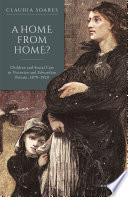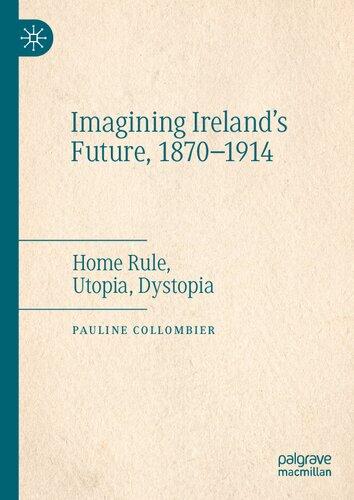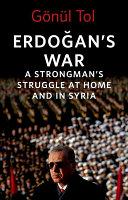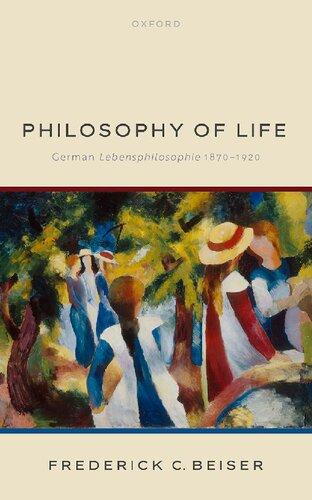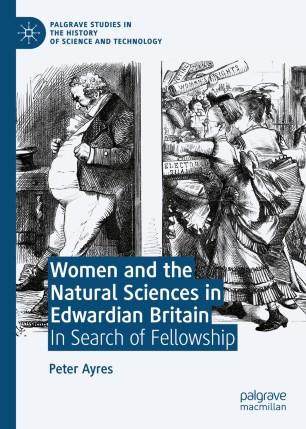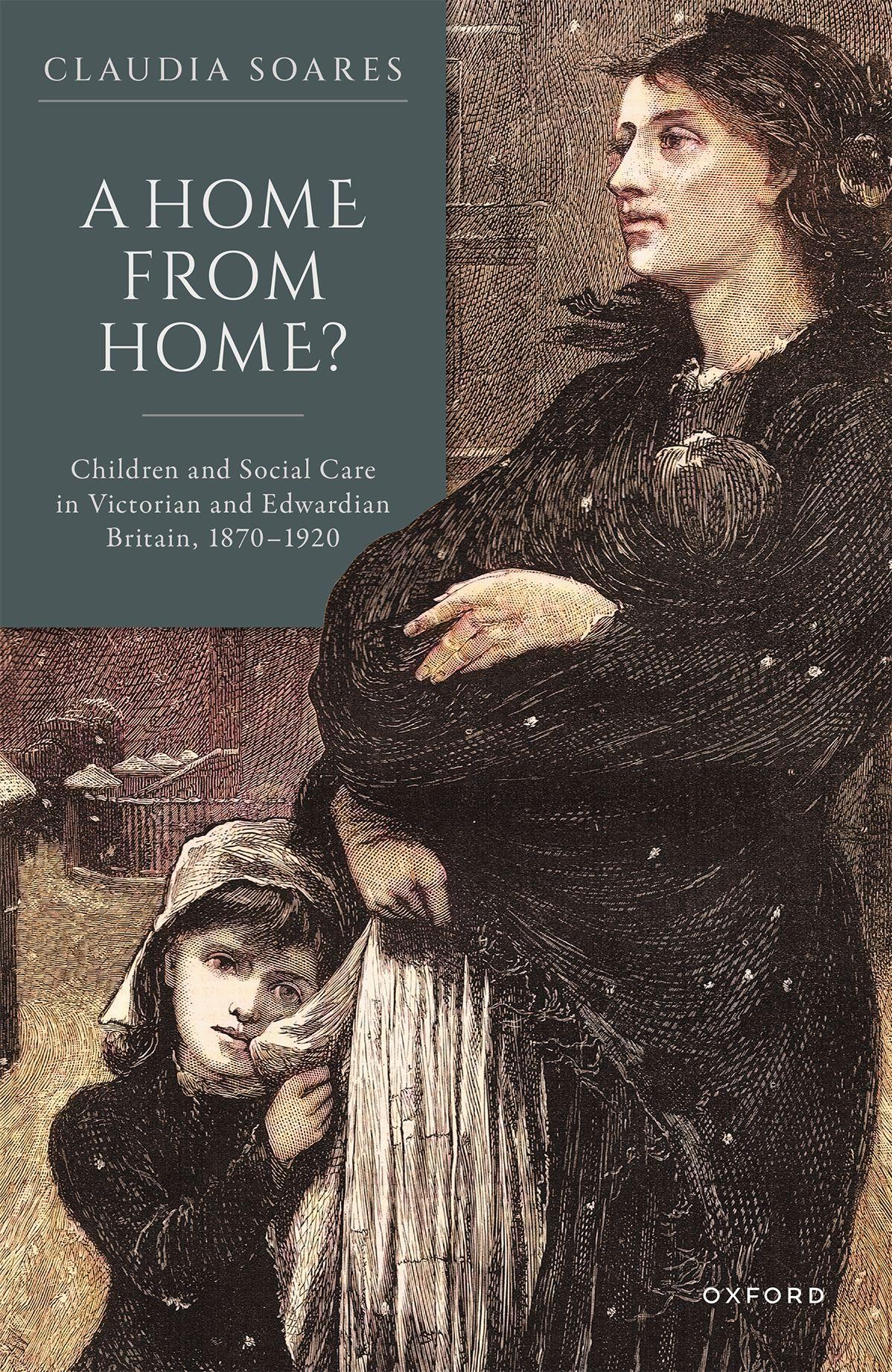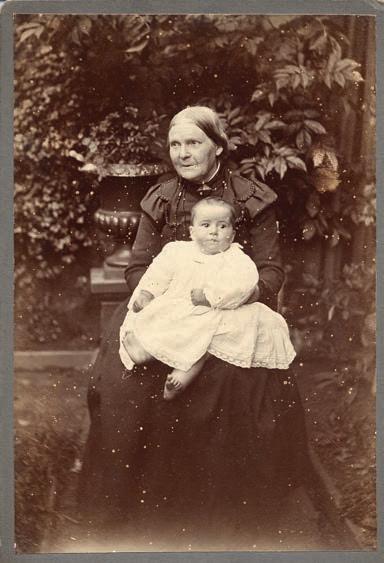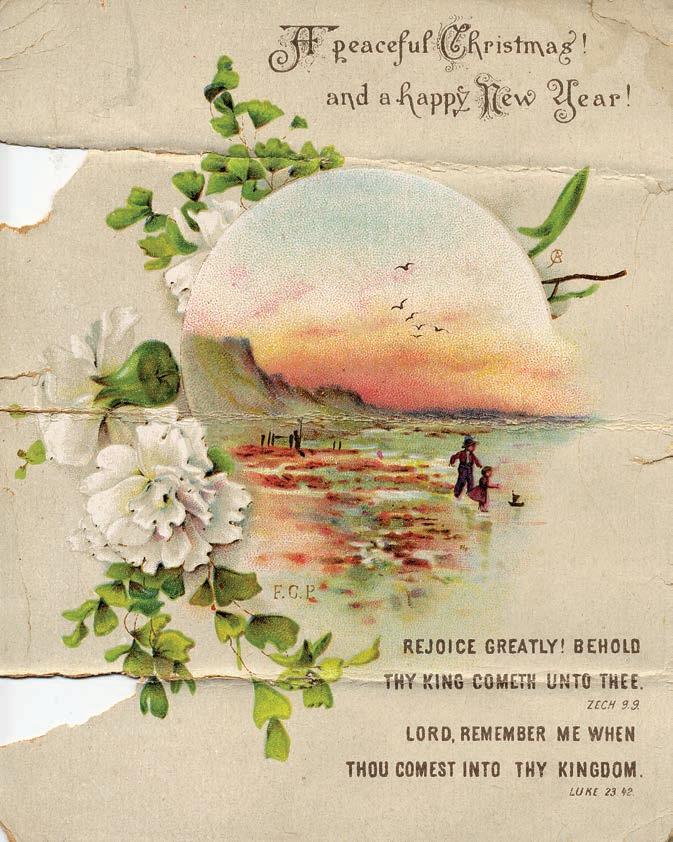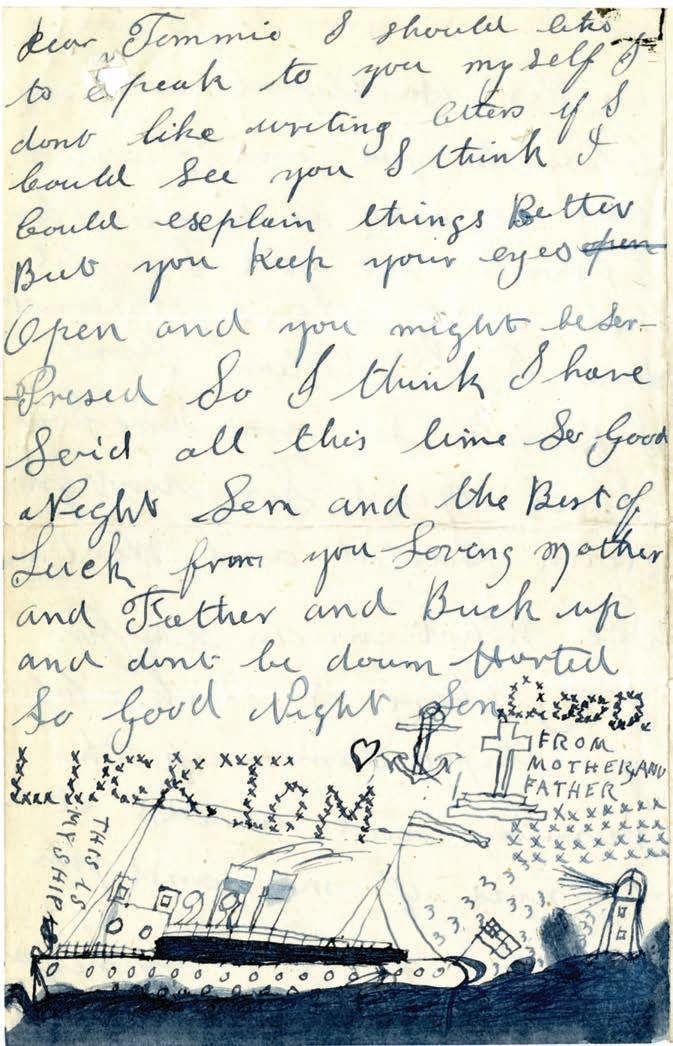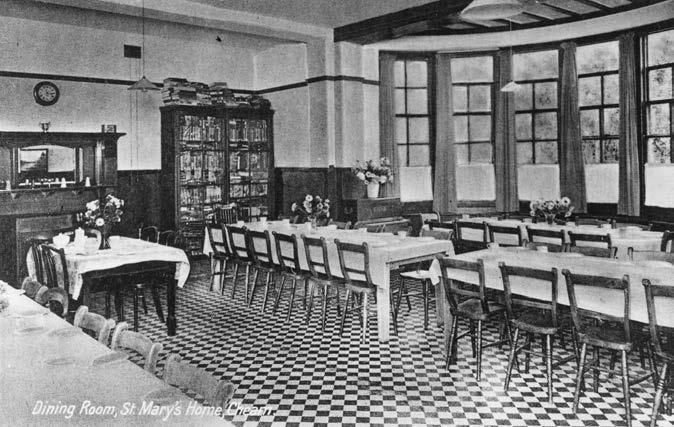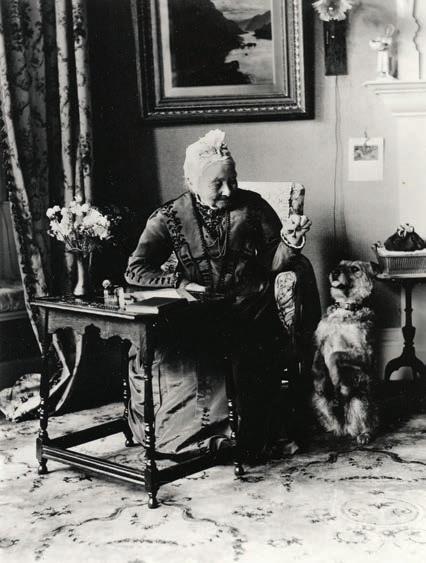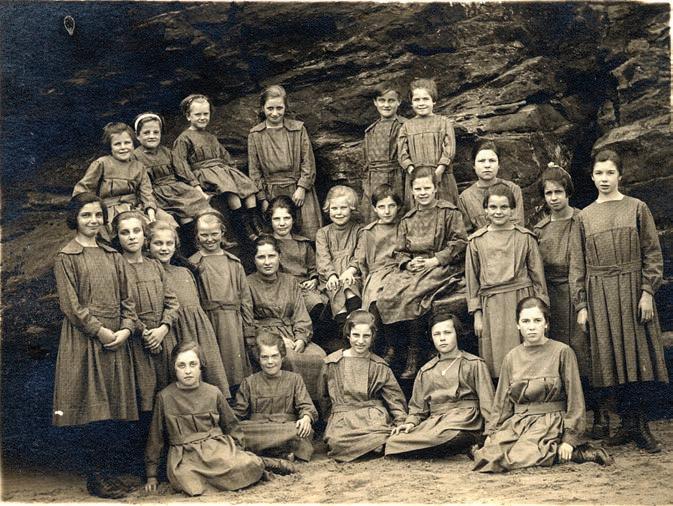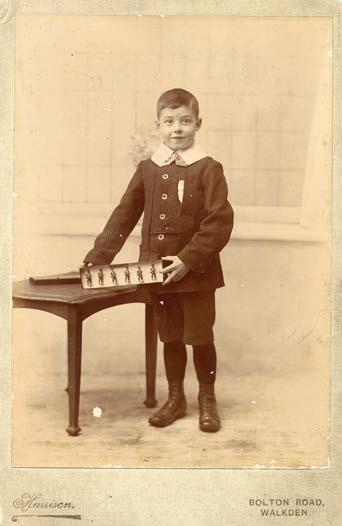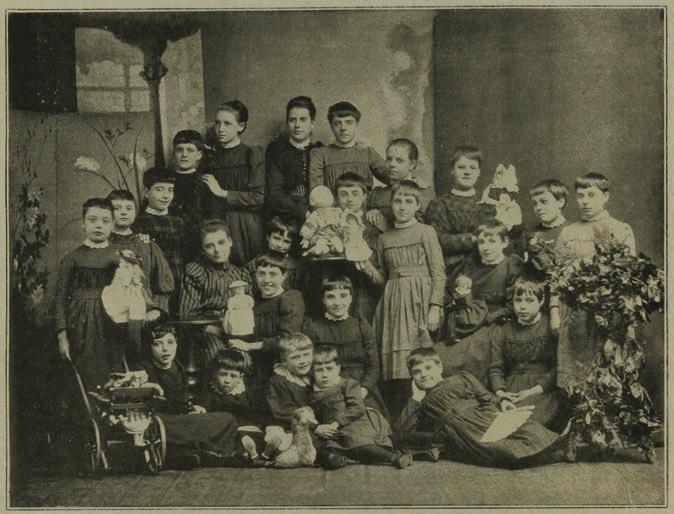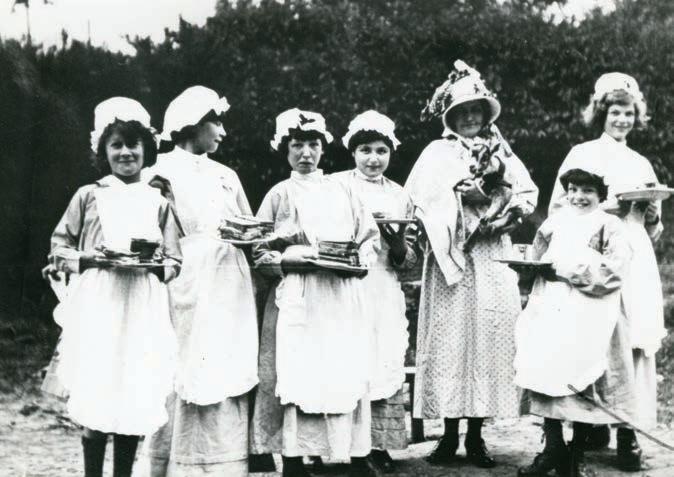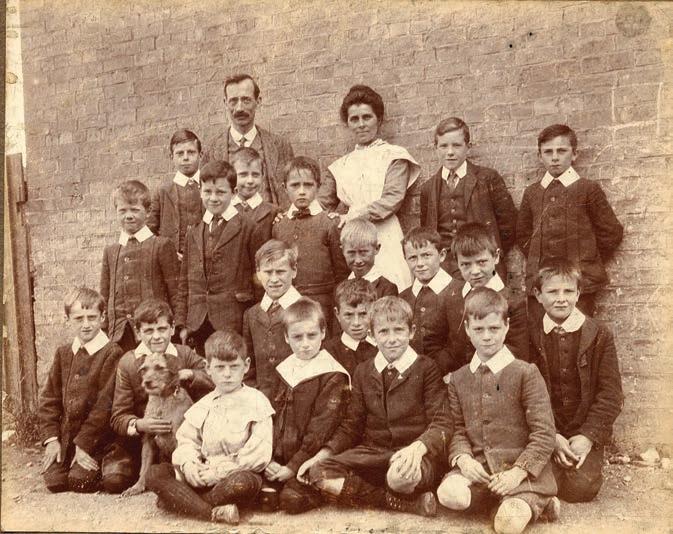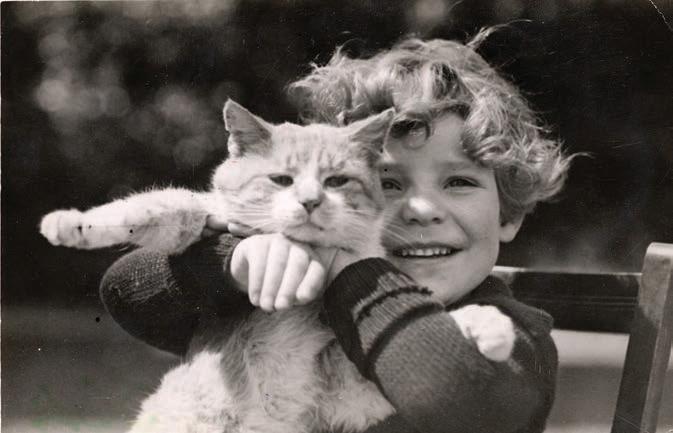A Home from
Home :
Children and Social Care in Victorian and Edwardian Britain, 1870-1920 Claudia Soares Visit to download the full and correct content document: https://ebookmass.com/product/a-home-from-home-children-and-social-care-in-victori an-and-edwardian-britain-1870-1920-claudia-soares/
More products digital (pdf, epub, mobi) instant download maybe you interests ...
Drinking in Victorian and Edwardian Britain: Beyond the Spectre of the Drunkard Thora Hands
https://ebookmass.com/product/drinking-in-victorian-andedwardian-britain-beyond-the-spectre-of-the-drunkard-thora-hands/
Imagining Ireland's Future, 1870-1914: Home Rule, Utopia, Dystopia Pauline Collombier
https://ebookmass.com/product/imagining-irelandsfuture-1870-1914-home-rule-utopia-dystopia-pauline-collombier/
Language Practices of Indigenous Children and Youth: The Transition from Home to School 1st Edition Gillian Wigglesworth
https://ebookmass.com/product/language-practices-of-indigenouschildren-and-youth-the-transition-from-home-to-school-1stedition-gillian-wigglesworth/
Home Sweet Home (Burgers and Brew Crüe Book 6) Lacey
Black
https://ebookmass.com/product/home-sweet-home-burgers-and-brewcrue-book-6-lacey-black/
Erdogan's War: A Strongman's Struggle at Home and in Syria Tol
https://ebookmass.com/product/erdogans-war-a-strongmans-struggleat-home-and-in-syria-tol/
A DIY Smart Home Guide: Tools for Automating Your Home
Monitoring and Security Using Arduino, ESP8266, and Android Robert Chin
https://ebookmass.com/product/a-diy-smart-home-guide-tools-forautomating-your-home-monitoring-and-security-using-arduinoesp8266-and-android-robert-chin/
Philosophy of Life: German Lebensphilosophie 1870-1920
Prof Frederick C. Beiser
https://ebookmass.com/product/philosophy-of-life-germanlebensphilosophie-1870-1920-prof-frederick-c-beiser/
Women and the Natural Sciences in Edwardian Britain: In Search of Fellowship 1st ed. Edition Peter Ayres
https://ebookmass.com/product/women-and-the-natural-sciences-inedwardian-britain-in-search-of-fellowship-1st-ed-edition-peterayres/
A Hero Comes Home Sandra Hill
https://ebookmass.com/product/a-hero-comes-home-sandra-hill/
AHomefromHome? ChildrenandSocialCareinVictorian andEdwardianBritain,1870–1920 CLAUDIASOARES GreatClarendonStreet,Oxford,OX26DP, UnitedKingdom
OxfordUniversityPressisadepartmentoftheUniversityofOxford. ItfurtherstheUniversity’sobjectiveofexcellenceinresearch,scholarship, andeducationbypublishingworldwide.Oxfordisaregisteredtrademarkof OxfordUniversityPressintheUKandincertainothercountries
©ClaudiaSoares2023
Themoralrightsoftheauthorhavebeenasserted FirstEditionpublishedin2023
Impression:1
Allrightsreserved.Nopartofthispublicationmaybereproduced,storedin aretrievalsystem,ortransmitted,inanyformorbyanymeans,withoutthe priorpermissioninwritingofOxfordUniversityPress,orasexpresslypermitted bylaw,bylicenceorundertermsagreedwiththeappropriatereprographics rightsorganization.Enquiriesconcerningreproductionoutsidethescopeofthe aboveshouldbesenttotheRightsDepartment,OxfordUniversityPress,atthe addressabove
Youmustnotcirculatethisworkinanyotherform andyoumustimposethissameconditiononanyacquirer
PublishedintheUnitedStatesofAmericabyOxfordUniversityPress 198MadisonAvenue,NewYork,NY10016,UnitedStatesofAmerica
BritishLibraryCataloguinginPublicationData Dataavailable
LibraryofCongressControlNumber:2022947761
ISBN978–0–19–289747–3
DOI:10.1093/oso/9780192897473.001.0001
PrintedandboundintheUKby ClaysLtd,ElcografS.p.A.
LinkstothirdpartywebsitesareprovidedbyOxfordingoodfaithand forinformationonly.Oxforddisclaimsanyresponsibilityforthematerials containedinanythirdpartywebsitereferencedinthiswork.
Formyfamilywithlove Preface Acrossthesecondhalfofthetwentiethandearlytwenty-firstcenturies,abundant evidencepointstothegrowingnumberofchildreninaseeminglyunfitandfailing socialcaresystem.Fromasearlyasthe1940s,childrenininstitutionalfacilities werenotedtoexperiencepoorphysical,emotional,andculturalcare.Andthe numberofchildrenincarehascontinuedtorise:increasingpovertyamong familiesfromthe1980shasresultedinthegrowthofthenumberofchildren accommodatedinthesocialcaresystem.Intheearlytwenty-firstcentury,this numberhascontinuedtorise,yearonyear.¹Atthesametime,therehavebeen systematiclocalauthoritybudgetcutsforsocialcaredeliverywhichhaveresulted inseriousdeficitsinthequalityofchildren’scare.50percentoflocalauthorities havesocialcareservicesjudgedasinadequateorrequiringimprovementattheir lastinspection.²Additionally,thesectorisfacingsignificantchallengesinrecruitingandretainingsocialcarestaff.
Meanwhile,theoutcomesofcare-experiencedchildrenacrossthetwentiethand twenty-firstcenturieshavebeenpoorandareoftenduetothefailureofstate agenciestoprovideeffectivesupportthatmeetsindividualneeds.Throughoutthis period,care-experiencedyoungpeoplehavebeenconsistentlyover-represented inthehomelessandprisonpopulations.Bytheearlytwenty-firstcentury, figuresshowthatoverathirdofcareleavers(39percent)arenotineducation, employment,ortrainingcomparedto13percentofyoungpeopleagednineteen totwenty-oneyears.Only13percentofcareleaversprogresstohighereducation byagenineteencomparedto43percentofallotherpupils.³Childabuseinthe socialcaresystemremainsatopicalissuesince TheTimes journalistAndrew Norfolk’sinvestigationintochildsexualexploitationin2011–12.Thisinvestigationexposedtheinadequaciesofchildren’shomesinRochdaleandRotherham andtheirfailuretoprotectchildrenfromsexualabuse,whichhasprompted subsequentinquiriesthatinvestigatetheextentofthisabuse.
Itisagainstthisbackdropthatthisbookexaminestheemergenceanddevelopmentofchildwelfarepolicyandpracticeacrossthekeyperiodof1870–1920,to
¹DepartmentforEducation, ChildreninNeedCensus,2020[https://www.gov.uk/government/ publications/children-in-need-census-2020-to-2021-guide],accessed24May2021;Departmentfor Education ChildrenLookedAfteron31March2020,SSDA903,2020[https://www.gov.uk/govern ment/publications/children-looked-after-return-2020-to-2021-guide],accessed24May2021.
²OfficeforNationalStatistics, MainFindings:Children’sSocialCareinEngland2020 and Local AuthorityLevelDataasat31March2020 [https://www.gov.uk/government/statistics/childrens-socialcare-data-in-england-2020],accessed24May2021.
³See ‘Earlyplans,1March2021’ athttps://childrenssocialcare.independent-review.uk/.
betteridentifytheundulatingnatureofpolicyandpracticethathasoccurred sincethenacrossthetwentiethandtwenty-firstcenturies.Ittracesandlocates anxietiesaboutchildren’scareandnurtureinwiderhistoricalcontext,atatime whenlegislationgaveagenciesgreaterpowertointerveneinfamilylifetosafeguardchildren.Atthistime,too,thequalityandnatureofchildren’ scarewas beingdebatedinParliament,whileinnovativechildcarepracticeswereimplementedinnon-stateinstitutions.Thisfocusprovidesuswithalongviewinwhich wecanmakebetterassessmentsaboutwhatmighthaveworkedwell(ornot) andwhy.Asthisbookdemonstrates,whilelegislation,policy,andpracticehas changedradicallyoverthelasttwocenturies,thereissignificantcontinuity betweentheissuesgrappledwithinthepastandinthepresent.
Thedeliveryofchildren’ssocialcareandchildren’sexperiencesofout-of-home carethusremainsoneofthemosturgentandpressingchallengesinsocietytoday. Thecompellingevidenceofanunfitsocialcaresystemhasresultedinarecent launchofamuchneededandlong-awaitedindependentreviewintochildren’ s socialcare,whichtheUKgovernmenthaslabelleda ‘onceinageneration opportunity’ toreformchildren’scareservices.⁴ Thisreviewexploreshowthe socialcaresystemmightworktoprovidechildrenwithafoundationofstability, safety,andnurturetoimproveoutcomesandexperiences.Care-experienced childrenandadultshaveuniformlyconfirmedthatthesefeaturesareessentialto helpthemachievetheirpotential,butaretooofteninconsistent,inadequate, orwhollyabsentinthecaresystem.⁵ Butquestionsabouthowtoprovidesafety, security,stability,nurture,andaffectiontochildrenincarehavealonghistory, andagencies’ attemptstoreplicatefamilialidealsincareprovisionarenotnew. Thisbooktracestheemergenceofthesequestionsandthesubsequentdebates, examineshowcareprovidersconceptualizedchildren’scareinthepast,and highlightstheofteninnovativeapproachesandpracticesadoptedbyagenciesin attemptstomanufactureanidealhomeandfamilyformsofcare.Bytakingthis longview,thebookoutlinestheshiftingideasaboutchildren’shomesandthe rolesthattheyshouldperform,whilealsouncoveringthewaysinwhichideas aboutnurtureunderpinnedcarepractices.Stability,safety,andnurture,then,are centralfeaturesofsocialcarethatthisbookinvestigates.Advancingknowledge abouttheseaspectsofwelfareprovisioncanhelptosetanewagendaaboutthe directionsthatsocialcarereformmighttakeinthefuturetohelpyoungpeople thrive.
⁴ https://www.gov.uk/government/groups/independent-review-of-childrens-social-care,announced 15January2021.
⁵ ScottishIndependentCareReview, ThePromise (5February2020)[https://www.carereview.scot/ conclusions/independent-care-review-reports/],accessed24May2021.
Acknowledgements Ihavemanypeopletoacknowledgeinthemakingofthis,my firstbook.Icould nothavecompletedthisbookwithoutthe financialsupportofmanyinstitutions. IgratefullyacknowledgetheArtsandHumanitiesResearchCouncil(grantref AH/IO18344/1)forfundingmydoctoralresearchonwhichthisbookisbased, andtheWellcomeTrust(grantref200434/Z/16/Z),whichawardedmeagenerous granttoexpandmyresearchtoexplorenewavenuesrelatingtothecareof childrenwithillhealth.Finally,aBritishAcademyPostdoctoralFellowship (grantrefPF170088)hasbeenformativeingivingmethetimeandspaceto reworkandcompletethisbook.Partsofthisbookwerewrittenonthetraditional landsoftheGadigalpeopleoftheEoraNation,andthetraditionallands oftheDharawalpeople.VersionsofChapters4and6appearedin Journalof VictorianCulture,23:1(2018),pp.1–24and HistoryWorkshopJournal,87(2019), pp.94–117,respectively.
Ihavebeensofortunatein findingbothamentorandafriendinJulie-Marie Strange.Iamindebtedtoheronmanyaccounts,notleasthercontinuedsupport ofmywork.Insupervisingmydoctoralthesis,shehasbeenthegreatestandmost excellentinfluenceonmymethodsofresearchingandwriting.Sheremains unfailinglygenerousinhersupportofmyworkandmycareer,providing mewithincisivefeedback,guidance,andreassurance,whileinspiringmetobe imaginativeandcreativewhenIhaveneededitthemost.
SpecialthanksmustalsogotoMichaelSandersandCharlotteWildman,both ofwhomprovidedvaluablefeedbackonvariousdraftsofthiswork.Iamalso gratefultoLucyDelap,SashaHandley,andJaneHamlett,whocontinuetobe especiallysupportiveofmywork,andfortheirvaluableandconstructivefeedback thathasshapedthebook.Iamalsogratefultootherkindcolleaguesandfriends fortheirstimulatingconversationsandintellectualsupportatarangeofconferences,workshops,andbeyond.Theyhaveheardvariousiterationsofmyideasand throughtheirquestioning,feedback,andsupporthaveshapedmyworkinvarious ways.ThankyoutoAlisonBlunt,CasperLaingEbbensgaard,GingerFrost,Rachel Hammersley,RhodriHayward,KatherineHolden,KateJames,GillianLamb,Vicky Long,MaryClareMartin,CatherineNash,StephanieOlsen,AlastairOwens,Siân Pooley,SimonSleight,RebeccaSwartz,JonoTaylor,AnnieTindley,andLauraTisdall.
TheChildren’sSociety’samazingarchivesmadethisbookpossible.Iam particularlygratefultoIanWakeling,EdwardRatcliffe,HelenaHilton,Gabrielle St-JohnMcAlister,andRichardWilsonatTheChildren’sSocietyArchive.They havefacilitatedthiswork,providingmewithtime,support,andexpertisewhich
hasbeensovaluabletomyresearch.MymanuscripteditorCathrynSteeleat OxfordUniversityPresshasbeenimmenselysupportiveintakingthiswork throughfrominitialproposaltopublication.Theanonymousreadersallprovided judiciousandvaluablefeedbackandguidance,whichhashelpedtosharpenmy keyarguments.
Finally,Iamgratefultobothimmediateandextendedfamilywhohaveoffered theirenduringlove,support,andencouragementthroughoutthisprojectand beyond.Moreover,Iamincrediblythankfulfortheirwillingnesstooffercareto ourson,Percy,whenIneededit.Suchsupport somethingthatmanyparentsin thisbooklacked makesmerealizejusthowluckyIam.Iamespeciallygrateful forthelifetimeofsupportandlovefrommyparentsPenelopeandNelson.Ialso thanktheendlesssupport,love,andpatiencefrommyhusbandAdamandson Percy Iloveyoudearly.AllofmythanksgotoAlexandHarri,andSandra, Lee,Yas,andMia,andtheAbalosfamily.Myfriendshaveofferedboundless encouragementandlaughter:thankyouespeciallytoJess,Matt,andFrida,Jo, Bob,CoraandFinn,Alice,Henry,Connie,andGeorge,andRichard,Rebecca, Willa,andLyra.
1.ASubstituteFamily?Contracts,Authority,andApplications
4.FeelingatHome?Stability,Security,andHomelinessinthe
5.AnIdealLifeforaChild?Children
2.1KnebworthCottageHome,Stevenage,Herts,1894
2.2Nurseandbaby,StOswald’sHome,Cullercoats,1898
5.3GardeningatStAndrew’sHome,Reading,1902164
5.4ThegirlsofStNicholas’ withtheirgoat,StNicholas’ Home,Pyrford, c.1915168
5.5TheHarveyGoodwinHomefamily,1916169
5.6InthegardenofStMartin’sHome, c.1910170
5.7TalbotManor,1947 friends!171
ListofAbbreviations CUTheChildren’sUnion
LSPCCLondonSocietyforthePreventionofCrueltytoChildren
MABYSMetropolitanAssociationforBefriendingYoungServants
NCHNationalChildren’sHomes
NSPCCNationalSocietyforthePreventionofCrueltytoChildren
OMCOddMinuteCoterie
OWS OurWaifsandStrays
WSSTheWaifsandStraysSociety
KnebworthCottageHome,Stevenage,Herts,1894
Matronandbaby, c.1885
ChristmascardtoMaudD.fromherbrother,26January1891
StMary’sHomeforGirls,diningroom, c.1915
MrsBaileyandherdog,StAndrew’sHome, c.1901
Girlsdoinglaundrywork,StMary’sHome,Herefordshire, c.1920
‘Atthebeach’,unknownhome, c.1915
StAidan’sHomeforBoys, c.1918
Boywithtinsoldiers,WorsleyHome, c.1916
‘TheMerryMaidsofMarylebone’,1893
ThegirlsofStNicholas’ withtheirgoat,StNicholas’ Home,Pyrford, c.1915
TheHarveyGoodwinHomefamily,1916
Prologue Inthesummerof1905,two-year-oldLucyL.wasadmittedtotheWaifsandStrays Society(theWSS),acharitablewelfareinstitutionthatprovidedhomestooutcast, destitute,andfriendlesschildren.¹Likemanyotherchildreninresidentialcare, Lucywasnotanorphan.Herfather,anarmyofficer,haddiedshortlyafterher birthin1903andhermotherhadsubsequentlystruggledtosupportthefamily. Lucy’smotherremarriedin1904,perhapsinthehopeofachievinggreater financialstability.Butbythesummerof1905,shewasinstraitenedcircumstances:shehadrecentlygivenbirthtoababyboy,George,andhadseparated fromherhusband.Tosurvive,Lucyandherfour-year-oldbrotherCharleswere receivedintoWSScare.²Lucylivedwithafosterfamilyfortenyears:Kateand RobertCheney,bothfarmersinSuffolk,andtheirthreechildren.Lucyattended thelocaldayandSundayschoolsandsharedabedroomwithoneofthefamily’ s biologicaldaughters.AWSSinspectordescribedLucyasabrightandkindchild andherschoolteachersaidshewashard-working,anxioustoplease,truthful,and honest.
Whenshereachedthirteen,theSocietyarrangedtotransferLucytooneoftheir largerhomes,StWinifred ’sinClapham,tobetrainedfordomesticservice.Kate wassadtopartwithher:shedelayedLucy’sdepartureforaweeksothatshecould buysomepersonalbelongingsforher.³LucylefttheircareinOctober1916,but Katefounditimpossibletostopthinkingabouther.InMay1917,shewrotetothe SocietytorequestthatLucyreturnhomeandberaisedasoneofherown.⁴ The matronatStWinifred ’sagreedthatLucywoulddowelltoreturntoKate:she hadstillnotsettledintotheinstitutionalhomeandherprogresswiththeCheney familyhadbeendecidedlybetterincomparison.⁵ Despitethematron’ srecommendations,theexecutivecommitteebelievedthatLucyhadenjoyed ‘toomuch freedom ’ withherfosterfamily,andbecauseherprogressatStWinifred’shad notbeensatisfactorytheymovedhertoasmallerhome,StBarnabas ’sin Lincolnshire.LucybeganworkingattheSociety’sStUrsula’sHomeinJuly 1918,andthematronnotedLucywas ‘anxioustostayhere’ becauseofher ‘fondnessoftheotherchildren’ . ⁶ Butthefollowingmonth,Lucy’smother
¹Case file11069.²Case file11070.
³Case file11069,letterfromK.CheneytoWSS,October1916.
⁴ Case file11069,letterfromK.CheneytoWSS,May1917.
⁵ Case file11069,reportonLucyL,May1917.
⁶ Case file11069,letterfromStUrsula’smatrontoWSS,14/8/1918.
requestedherreturnhome.⁷ Lucy’smothermaywellhaverecognizedher daughter’sabilitytocontributetothehouseholdnowthatshewasemployable. Lucywrotetotheheadoffice,however,statingherpreferencetostayatStUrsula’ s andthatshewas ‘verythankful’ tothehomefortheircare. ⁸
In1920,LucyleftStUrsula’stoworkinalaundryinArdingtonWick, Berkshire.Withahealthysavingsaccountof£7,1shilling,and7pence,this movemarkedher firststepstowardsindependence.⁹ Shecontinuedtokeepin touchwithseveralstaffmembersandherfostermother,Kate.ByMarch1921, however,Lucy’scircumstanceshadchanged.Hermotherwassufferingfrom consumptionandwasbroken-heartedthatLucywasstayingawayfromher.¹⁰ Lucyreturnedhometocareforhermother,andwrotetoherformermatronat StUrsula’s,stating:
Iamenclosing5shillingsasakindnessforallthatwasdoneformewhileIwasin thehome.Idohopeyouarefeelingbetter...IwasverypleasedMrCordellcame toseeyou.Istillwritetohim.HowdoyoulikeStWinifred’s?Iwillcomeandsee youwhenIcomehomeasitwouldnotbeveryfaraway...Idomissthehome verymuch...¹¹
Theletteranddonationarticulatehergratitudeandesteemforherformercarers, whileherdesiretokeepintouchindicatesherstrongattachmenttothehome.If Lucywroteagainorroutinelytomaintainherrelationshipswithstaffmembers, wearenotaffordedaglimpseofthiscorrespondenceorherprogressbeyondthis point.Itisprobablethatthissingleletterwaspreservedwithhercarerecord becauseitrequiredareceipttobeissuedacknowledgingherdonation;further lettersremainprivateexchangesamongthoseshehelddearestandclose. Lucy’scaseistypicalofthethousandsofchildrenthatpassedthroughWSScare betweenitsestablishmentin1881and1920.Importantlytoo,herexperiencesof fosterandresidentialcareareindirectcontrasttonumerousstoriesaboutwhat institutionsdidtochildren.Theseworksemphasizedtheharshsystemsofdisciplineandreform,themiserable,oppressive,andbleakinstitutionalenvironments thatweresupposedtoofferchildrena ‘home’,andchildren’sexperiencesof trauma,abuse,andexploitationsufferedatthehandsofcruelstaffmembers. Suchgloomynarrativeshavebeenpervasiveinshapingunderstandingsofwhat lifewaslikeinavarietyofstate-andvoluntary-runwelfareinstitutionsoperating acrossthenineteenthandearlytwentiethcenturies.CharlesDickens’ s OliverTwist perhapsbestencapsulatesthisviewofthevulnerableorphancastadriftinthe
⁷ Case file11069.Theoriginalletterdoesnotsurvive,butresponsesconfirmthemother’srequest.
⁸ Case file11069,letterfromLucytoWSS,20/9/1918.
⁹ Case file11069,PostOfficesavingsbook.
¹
⁰ Case file10069,letterfromLucytoRudolf,12/3/1921.
¹¹Case file11069,letterfromLucytoStUrsula’s,12/3/1921.
worldandthebrutal,dehumanizingconditionsofinstitutionallife.Whilethiswas therealityformanychildren,thereareequallycountlessstorieslikeLucy’s,where paidcarersandinstitutionsofferedsafety,stability,andlovingrelationshipsto children.LikeLucy ’sletterstoherformercarers,numerousothercarerecords demonstratethatchildrenandstaffmembersforgedaffectiveinterpersonalbonds, andthatcontactwasoftensustainedforseveralyearsfollowinginstitutional discharge.Someoftheselettersindicatethepositiveandmeaningfuleffectsthat institutionsandtheirstaffhadinchildren’slives,andarticulateyoungpeople’ s senseofsadnessaboutleavingtheinstitutionalhomeandthefriendstheyhad madethere.
AHomefromHome? isaboutchildren’sexperiencesofresidentialcareinthelate nineteenthandearlytwentiethcenturies,atatimewhenwelfareprovisionwas rapidlydevelopingamidconcernabouthowbesttocareforarisingpopulationof destitute,neglected,andorphanedchildren.Thebookinvestigatestheexperiences ofthisgroupofchildrenandtheirfamiliesandunearthshowtheyinterpretedand respondedtovariousformsofwelfareprovision.ItusestheWSSasacasestudyto investigatetheideologies,aims,andobjectivesoftheseinstitutionsandtobetter understandhowtheyperceivedoftheirroletohouse,carefor,andnurture children.Beyondsimplydiscipliningandreformingchildren,theWSS,like otherinstitutions,understoodtheirmissiontocentreonprovidingasenseof home,family,andbelongingtothewaifsandstraysofsociety.Itwasnotenough tosimplycare for thesechildren:theSociety’sstaffmustcare about thesechildren.
Byfocusingonwelfareprovisionatatimewhennewideasabouttheimportanceofhomeandfamilytochildren’scareanddevelopmentgainedprominence, thebookchallengesorthodoxiesofinstitutionalchildhoodasmiserable,bleak,and oppressive.Theseperceptionsofinstitutionalchildhoodhaveendured:notonly didtheyshapecontemporaryunderstandingsofinstitutionalchildhoodspentas uniformlynegativeandpunitive,buthistoricalscholarshiphasalsotendedto focusonthesystemsofreformanddisciplineenactedwithinthesespacesalmost exclusively.Attendingtofeaturesofhome,family,andbelonginginsocialcare provision,Iargue,providesnewinsightsintotheidealsandobjectivesthatunderpinnedmanyoftheinstitutionsoperatingatthistime.ByexploringtheSociety’ s practicesduringthelatenineteenthandearlytwentiethcenturies,thebookcontributesnotonlytodebatesaboutthedevelopmentofmodernwelfareandsocial careprovisioninthedecadespriortotheestablishmentofthewelfarestatein Britain,butalsotodiscussionsabouttheuniquefeaturesofvoluntaryprovision whensetagainstabroaderandshiftinglandscapeofwelfarepolicyandpractice.
AHomefromHome? departsfromtheapproachesusedinpreviousscholarship toofferaradicallydifferentviewoftheroleandfunctionofchildren’sinstitutions inthelatenineteenthandearlytwentiethcenturies.Centraltothebook’ s
argumentisthathome,family,andbelongingweresignificantdimensionsin childcarepracticealongsidebroaderobjectivestorescueandreformthechild victimsoffamilypoverty,immorality,andvice.Despiteunderpinninginstitutionalpoliciesandpracticesatthetime,theseapproachestochildren’scarehave beenlargelyoverlookedbyhistorians.Thebookcallsuponanewbodyofevidence notyetexaminedindepthbyhistorians therichrecordsoftheWaifsandStrays Society,oneofthelargestchildren’swelfareinstitutionsafterBarnardo ’ s tooffer freshperspectivesonthehistoryofchildren’scareandthespeci fictypesofcaring practicesthatheldspecificculturalandideologicalmeanings.Byusingalarge corpusofprivatecorrespondenceandchildren’sindividualcarerecords,thebook uncoversthereallives,experiences,andattitudesofchildrenplacedincare,and theirfamilies.Itisdistinctiveinprivilegingthesevoicesandviewsandlocatingthe subjectivitiesofwelfare-recipientchildrenandfamilieswithinthevoluntary welfaresystembetween1870and1920.
Bypositioningthefamilycentrallyandinattemptingtoreconstructresponses tocareprovision,thebookyieldsinsightsintohowparents,children,andother relativesworkedtogethertosustainaffectiverelationshipsduringchildren’ s institutionalization.Itfurtherhighlightshow,despitepoliciesthataimedto severchildren’srelationshipswithrelatives,institutionscouldbemuchmore flexibleandaccommodatingintheirapproachtoandtreatmentoffamilymembersandtheirinvolvementwithchildren. AHomefromHome? alsorevealshow institutionsattemptedtoreplicatefamilialidealswithintheirresidentialhomes andexamineshowchildrenrespondedtothesepracticesinpersonalcorrespondence.Turningtothecorrespondencesentbetweenchildrenandstafftounderstandhowfamily-typerelationshipsweresustainedfollowinginstitutional discharge,thebookdismantlesthenotionthatinstitutionscaredlittleforthose intheircare,andthattheywerefocusedsolelyonchurningoutwell-adjusted, industriouscitizens.Byfocusingonthespatial,temporal,andmaterialworldof theinstitution,thebookalsounearthsnewpossibilitiestointerpretthelived experiencesofinstitutionalinhabitants.Itadvancesknowledgeaboutpractices thatcentredonideasofstability,comfort,andnurtureandexploreshowthese featureshelpedtoconstituteasenseofhomelinessforinhabitants.
Thus,byaskingdifferentquestionsofsurvivingsourcesanothernarrative emergesthathighlightsthediversityofcareexperiences.Attimes,institutions offeredprotection,hope,andlovetochildren.Archivalevidencesuggeststhat somechildrenfeltattachment,affection,andaffinitywithstaffandco-residents thatheightenedfeelingsofintimacyandconnection.Thesestoriesprovidecounterpointtothetraditionalnarrativesofmiseryandcrueltythathavedominated manyhistoriesofchildren’sinstitutionalcare.Toacknowledgethatinstitutional experiencescouldbemeaningfulandpositive,however,isnottosuggestthat thiswasthecaseforallchildreninresidentialcare.Thepoliciesandpractices ofvoluntarychildcareinstitutionsatthistimewerevaried.Althoughsystemsof
accountabilityandinspectionensuredsomestandardizationofpracticesand qualityassurance,theseinstitutionsretainedrelativeautonomyovertheir routinesandcarepractices.Asaresult,children’sexperiencesevenwithinthe sameinstitutionwerewide-ranging.Moreover,theirunderstandingsandmemoriesofcarewerediverse.
Children’scarerecordsareunsurprisinglysilentinrevealinginstancesofabuse andtrauma.Asotherhistorianshavenoted,therearechallengesinsearchingfor thetextualtracesofchildabuse,particularlysexualabuse,inhistoricalarchives, notleastbecausemuchoftheterminologyassociatedwithchild(sexual)abuseis relativelyrecent.¹²Additionally,overtime,textualtracesofchildabusemaywell havedisappearedfromthearchive,iftheyappearedatall.Therewerefew opportunitiesavailabletoyoungpeopletoreportabusetheyexperiencedatthe handsofmorepowerfulindividuals.Iftheydid,manyreportsofabusewere unlikelytohavebeentakenseriouslyorinvestigated.AsLucyDelapnotes,traces ofchildsexualabuseoftenonlyappearinthearchiveswhereacomplaintwas made,andaninvestigationtookplace.¹³Ithasonlybeeninrecentdecadesthat somesurvivorshavefeltabletocomeforwardanddiscloseinstancesofmistreatment,exploitation,trauma,andabuse,butveryoftenasignificantperiodoftime mightelapsebeforedisclosureoccurs.¹⁴ Thedisappearanceofhistoricalrecords mightalsoaccountfortheparticularsilencesandgapsaboutchildabuse. Institutionalarchivesareconstructed,regulated,andshapedbyvariousactors overtime,andtheremoval,concealment,ordestructionofunsettlingrecordsin archiveshasoccurredaroundtheworldinordertoprotectandpreservethe reputationsofthoseinpower.
Inthesampleofcasesusedinthisbook,thereareonlyahandfulofcasesin whichtherearesuggestionsofchildren’smistreatment.Thesecomplaintsare usuallyaboutphysicalpunishment,ratherthanotherformsofabuse,andreveal questionablemethodsofpunishmentanddisciplinedeployedbysomestaff. Moreover,children’sactions deliberateandinvoluntary suchasrunning away,severingcontactwithstafffollowingdischarge,andbedwetting,canbe suggestiveofattemptstocopewithill-treatmentandtrauma.Whilearchival tracesofinstitutionalchildabusemightbescant,manymorerecordshighlight theabusethatchildrenexperiencedwithinthefamilysetting.Someofthisabuse wasthecausefortheiradmissiontoinstitutionalcare,butforothers,their experiencesofabusemightonlyhavebeenrevealedfollowingapplicationsor referralsmadetotheSociety.
¹²AdrianBingham,LucyDelap,LouiseJackson,andLouiseSettle, ‘HistoricalChildSexualAbusein EnglandandWales:TheRoleofHistorians’ , HistoryofEducation,45(July2016),pp.411–29.
¹³LucyDelap, ‘“DisgustingDetailsWhichAreBestForgotten”:DisclosuresofChildSexualAbuse inTwentieth-CenturyBritain’ , JournalofBritishStudies,57(January2018),pp.79–107.
¹⁴ Delap, ‘“DisgustingDetailsWhichAreBestForgotten”’,p.80.
